Monosynth Envelopes and Oscillators (and how to do them right)
Envelope Generators (A.K.A. Transient Generators)
ADSR Basics
The most common type of envelope generator found in analogue monosynths is the very
useful and versatile ADSR model. This allows a whole range of musically useful 'shapes'
of synth sounds to be created. The name "ADSR" comes from the names of the four parameters:
A - Attack (Time),
D - Decay (Time),
S - Sustain (Level),
R - Release (Time)
The Attack time is the length of time it takes an envelope generator output voltage to
rise from 0 volts (with caveats...) to its peak value of say 5 or 10 volts (again, with caveats, more later...).
The Decay time is the length of time it takes the output to fall from the peak value to the
Sustain Level. Sustain is the level at which the output will remain for as long as you hold
down a key. The Release time is the length of time it takes for the output to fall from the
Sustain level and return to 0 volts.
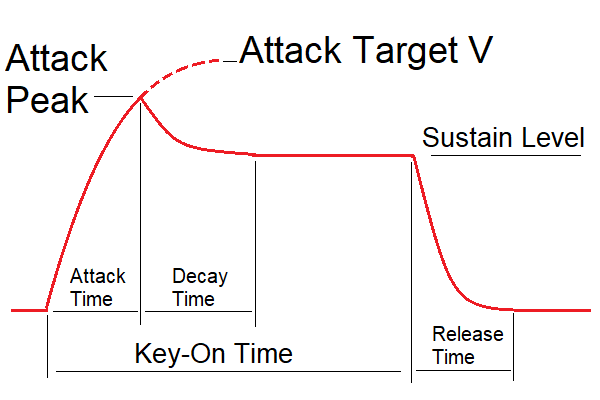
Example ADSR settings
Using these four parameters, you can create a multitude of useful envelope shapes which can
be used for both imitation of natural acoustic instruments, and purely synthetic (though musically
pleasing) sounds. For example:
Piano (A = 0 sec, D = 10 sec, S = 0, R = 150 ms).
This sound will rise to full volume almost instantaneously,
which simulates the effect of the hammer hitting the string. The Sustain level is set to 0, so
the sound will gradually decay from full volume to silence at a rate determined by the Decay
Time. When the key is lifted, it quickly returns to 0 (silence) at a rate determined by the
Release Time. This simulates the damper covering the string in a real piano. To further simulate
a real piano, it would be necessary to make the Decay Time longer for low notes and shorter for
high notes. It's unusual to be able to control Decay Time automatically in an analogue machine,
but it is a very common feature in digital synths. I believe this was first introduced with the
DX7, but I'm happy to be corrected on that.
Bowed String (A = 1 sec, D = 1 sec, S = 8, R = 500 ms).
This sound will fade in from silence to full volume over the course of one second. It will
then take about a second to reduce from full volume to 80% (Sustain = 8), where it will stay
for as long as the key is held on. Once the key is released, it returns to silence over the
course of 500 ms. A very nice quirk of this shape is something that occurs when the player
releases the key during the Attack phase. The envelope generator will immediately switch over
to the Release phase, and return to silence at a rate determined by the Release Time. This
gives a degree of 'touch sensitivity' to the sound; the shorter the duration of key press, the
lower the volume that the envelope generator manages to reach within the Attack phase. For a
great example of this effect, listen to "Village Ghetto Land" by Stevie Wonder.
Explaining Different ADSR Envelope Generator Behaviours
A Simple Electronic Explanation of How Envelopes Work
An Attack-Decay-Sustain-Release (ADSR) envelope generator is a very simple analogue resistor-capacitor
(RC) charge / discharge device which produces transient voltage shapes for controlling
analogue synthesizers. Here is an extremely simplified view of it (which omits buffers,
amplifiers, attenuators, PSU, etc).
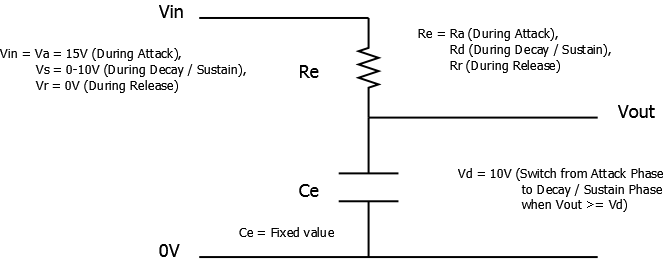
The output voltage (Vout) changes over time dependent upon the value of the input voltage (Vin)
and the value of the envelope resistor (Re). The envelope capacitor (Ce) is a fixed-value
capacitor which works with the varying values of Re to produce smooth, exponential voltage
curves during the Attack, Decay and Release phases of the envelope cycle.
Normally, an envelope's Vout would be sitting at 0V, and would be waiting for a key press ("gate on").
On receipt of a gate on signal, the envelope generator moves into the Attack phase of the envelope.
A large voltage is applied to Vin, and Re is set to the Attack time, Ra.
The reason for Va to be so high is that a purely exponential Attack just sounds odd, and unmusical.
By using the lower 2/3rds of the Attack exponential curve, it becomes more linear and musically
pleasing. Decay and Release curves sound best when they are simple exponential discharges, however.
Anyhow, moving along, if we should release a key during the Attack phase, then Re will change to
the value of Rr, and Vin will become 0V. Capacitor Ce will follow an exponential discharge curve
back down to 0V at a rate determined by Rr.
It's interesting to note at this point that the MiniMoog shared the same resistance value for Rd
(Decay Rate) and Rr (Release Rate) – the single control marked 'Decay' in each envelope generator.
The exception to this rule was when you had the 'Release' switch (to the left of the keyboard) set
to 'Off', in which case Rr became zero, and notes would finish immediately once you lifted your
finger from the keyboard).
Anyhow, moving along, if you lift your finger on the keyboard long enough for Vout to become
greater than or equal to the Decay Phase switchover voltage (10V in our example), then the
envelope generator would move into the Decay/Sustain Phase. At this point, Vin becomes equal
to the Sustain Level (Vs), and the envelope resistance becomes equal to Rd (Decay Rate). So,
in most cases, the envelope capacitor would start an exponential discharge process from Vd down
towards Vs, at a rate determined by decay resistance Rd. Eventually, Vout will be so close to Vs,
that you could say it had reached the Sustain Phase. Vout will remain steady at Vs until the key
is released.
A quirk of the MiniMoog is that the envelope generators couldn't tell when a new note was played
on the keyboard whilst the original note was still being held (i.e. playing legato). The
oscillators would move to the new note value (the lowest note had priority), but the envelopes
would be oblivious to this. (This was not the case in other synths, as we will see, later).
If the Gate signal went to Off during the Decay/Sustain Phase, then the envelope generator enters
the Release phase. Re would become set to Rr, and Vin would become set to 0V. This would cause Ce
to discharge to 0V at a rate determined by Rr.
Now here's the interesting thing - perhaps THE MOST IMPORTANT THING YOU WILL EVER LEARN
about (proper) envelope generators: If an EG is in its Release Phase, but it hasn't reached 0V yet
(i.e. the filter is still going "bzzzzzzaaaaeeeeoooowwww" or the amplitude envelope is still sounding),
AND if you then press a new key at that point (Gate On), then you go back into the Attack Phase,
but with an initial value which is NOT ZERO, but the current value of Vout.
That's it: You've discovered the secret of the universe!
There are a few subtleties, but in essence that is all you have to know: The charge on the envelope
capacitor does not Reset To Zero (RTZ) if you go into the Attack phase during an incomplete Release
phase. Now, don't get me wrong – I know a LOT of synths (especially virtual analogues and analogues
with digital envelopes) DO in fact perform a RTZ on the capacitor (real or virtual) on every new
key event. But they are doing it wrong if it's a monosynth.
Consider the following Finite State Machines (FSMs):
Number 1 - The traditional MiniMoog response (or SH-101 in GATE-only mode):
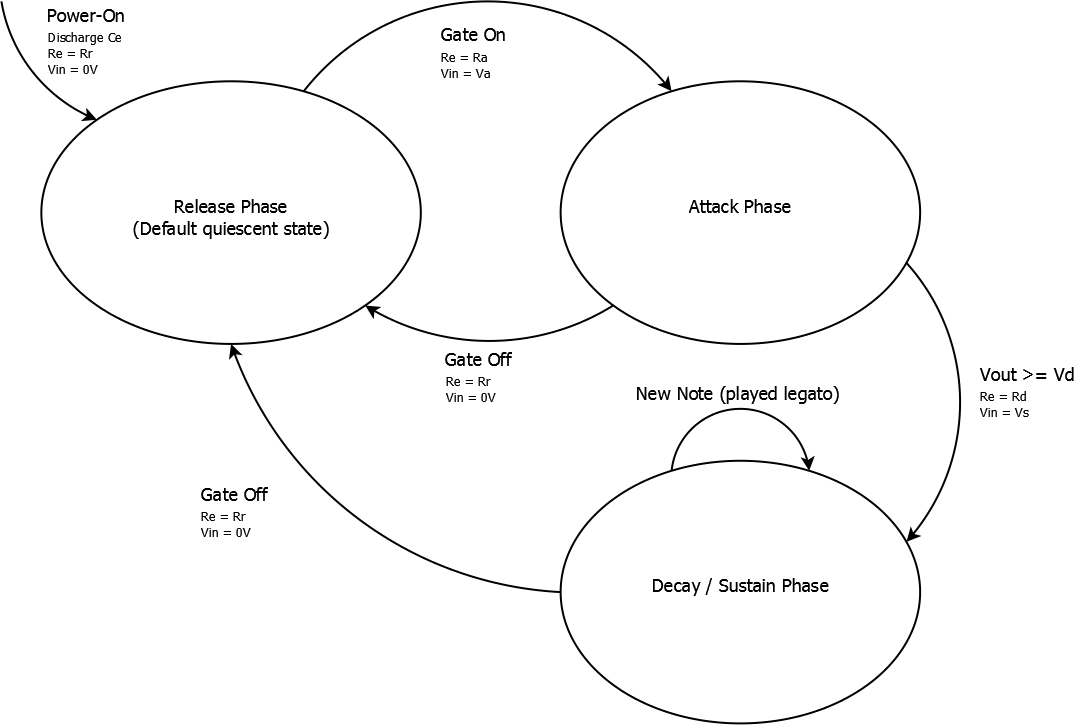
Number 2 - The Roland SH-101 (GATE+TRIG) or ARP Odyssey Response:
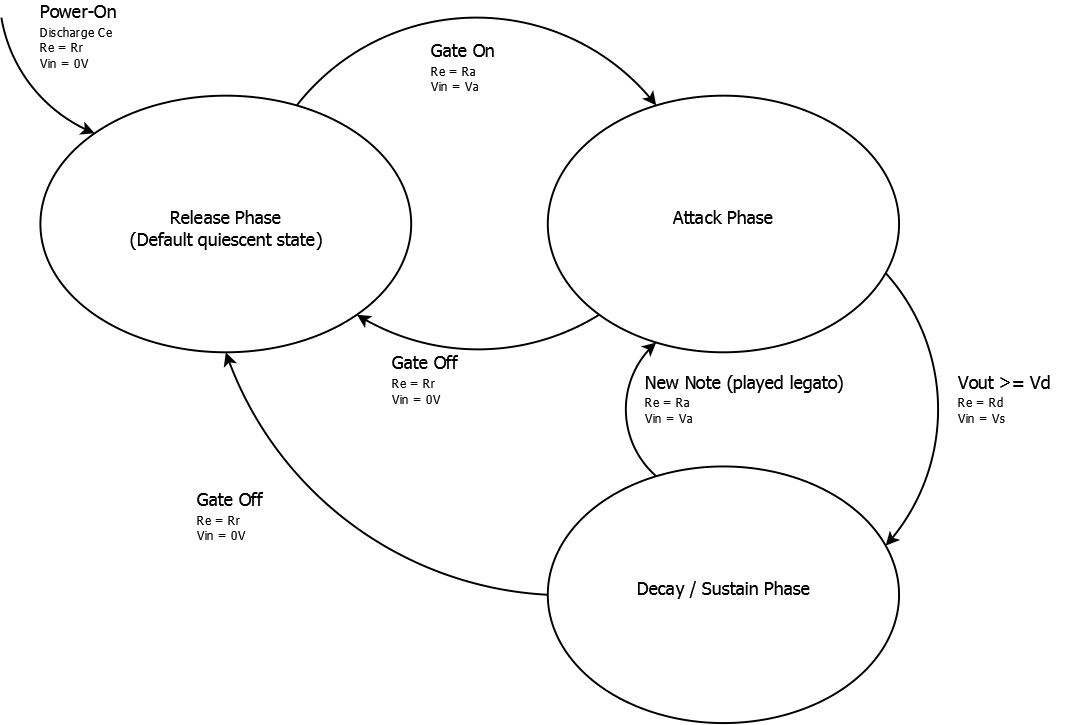
The subtle difference here is that when a new note is played, whilst still holding the original note
(i.e. legato trills, etc), then the state machine re-enters the Attack Phase, with Re = Ra, and Vin = Va.
This is the reason why the ARP Odyssey was considered superior (i.e. more responsive) for fast keyboard
solos over the MiniMoog.
Now, it is time to shield your eyes, for we are about to reveal the spawn of Satan: The monosynth with a
Reset To Zero response in the Attack Phase.
Remember: What has been seen cannot be un-seen!
Number 3 - The Korg Prophecy Response (Return To Zero):
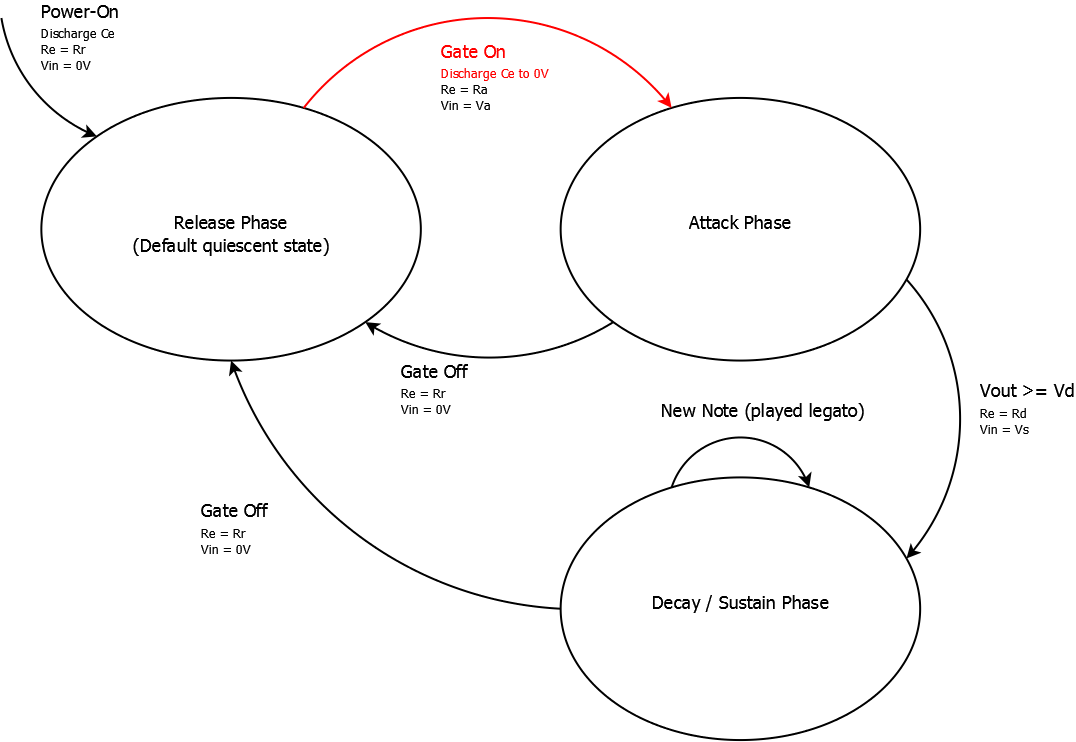
On first impressions, this looks very similar to the MiniMoog response. And in fact, the first note
you play would behave very similarly to a MiniMoog, too. Things get ugly however, if you take your
fingers off all keys and the envelope goes into a nice long release phase. What happens if you
press a new key?
BLAMMO!
The envelope capacitor is discharged to 0V before anything else.
If this was controlling a Voltage Controlled Amplifier, your nice release phase would be stopped
dead in its tracks (possibly accompanied with a big old 'thump' or 'click' if the waveform being
amplified wasn't at a zero-crossing point: i.e. pretty much every time). The Attack Phase for the
newly pressed key starts right back at 0V, rather than gently rising from the point you had
reached on the Release Phase.
Now, I can understand the reasons for implementing an RTZ response in a polysynth voice's
envelopes. Due to voice cycling, other voices can still be performing their Release Phase whilst
a new voice starts its envelope cleanly from a guaranteed initial state. I GET that.
However, if you're designing envelope generators for a monosynth (or even a mono mode on a polysynth),
then RTZ should only ever be an option. An option, moreover, which should be switched OFF by default.
Voltage-Controlled Oscillators (VCOs)
A Monosynth's VCO(s)
The Voltage-Controlled Oscillators in a monosynth are the source of pitched waveforms
which form the basis of a musical sounds. A tuning system known as Volt-Per-Octave means
that for every volt increase at the VCO input, the output frequency will double (a musical
interval of one octave). Therefore, the keyboard of a monosynth should output a voltage
which increases by 1/12 of a volt for every semitone. The keyboards on old monosynths
would have two outputs: Control Voltage (CV) and Gate.
Gate can take two forms, depending
on the manufacturer. The most common is for a positive voltage to be present whenever a key
is pressed, and zero volts when keys are released. Other manufacturers (notably Moog), use a
system known as "S-Trig". This means that the input to the Envelope Generator(s) is in the
form of a switch. When a key is pressed, the switch closes and the EG is triggered. When
the key is released, the switch opens again and the EG switches to its Release phase. You
can convert a "Pulse Gate" to an "S-Trig" using a relay or transistor circuit.
Keyboard CV Out will track either the lowest note played (Low Note Priority) or the highest
(High Note Priority). There is a circuit called "Sample and Hold", which reads the value of
the keyboard CV whenever the Gate signal turns on, and holds that value (in a capacitor)
whenever the Gate turns off (i.e. when all keys are released). This ensures that the
oscillators will still be generating the same keyboard pitch, even after the last key has
been released. This is essential to ensure that last keyboard pitch continues to sound
during the Release phase of the volume envelope.
It's important to remember that even when the output of a monosynth is silent, the VCOs
will still be oscillating at the frequency dictated by the most reecent key pressed. This
isn't immediately obvious on synths with just one VCO. However, if you have two VCOs, with
fine detune between them, then they will be continually 'beating' against each other, which
sounds a bit like a phaser pedal. If two VCOs are separated in frequency by 0.1 Hz, then the
cycle of this phasing sound will be 10 seconds in duration. If you play the same note on
the keyboard with a square, organ-like envelope, then you will hear the oscillators on a
different part of that overall cycle every time you press a new note. In addition, your
brain 'keeps track' of where the oscillators are within the cycle, so you build up an
expectation of where you will be when you next press a key.
Now, it's "no bother" for an analogue monosynth to have the VCOs running all the time (even
when the synth output is silent). However, in a soft-synth, it is easy to see how this could
be considered very inefficient (from a programmer's point of view). If a programmer decided
that whenever a soft-synth voice was silent, then they would stop the 'virtual oscillator'
subroutine from being executed. In this situation, the programmer has three choices when
restarting the virtual oscillator:
1 - Restart the oscillator from the point in its cycle when it was stopped.
2 - Restart the oscillator at a fixed point in its cycle.
3 - Restart the oscillator at a random point in its cycle.
With option 1, you would hear something similar to the "pure analogue" situation described
above: That is, each new note would sound in a consecutive segment of the overall "beat"
phase cycle. The only difference would be that with an organ-style envelope, the beat cycle
would not advance while the output was silent, so the oscillator output will fall out of sync
with your 'internal' cycle.
Option 2 is quite a different kettle of fish: Every time a new note sounds, it would pick
up its beat phase cycle at exactly the same point for every note. This would lead to every
note sounding the same, eliminating the sense of movement that is so desireable.
Option 3 breaks the monotony of Option 2, but sounds far less satisfying than being able
to track the beat phase cycle inside your head.
From what I can tell, the Arturia MiniMoog VST operates in the "pure analogue" fashion,
i.e. The virtual oscillators continue to run in the background, even when the overall
output signal is silent. It would appear that the original Arturia Modular V used the
Option 3 approach, restarting all oscillators from a new random point with every new
note on event. However, all credit to the Arturia team, they have made the latest version (V3) behave correctly for oscillators and envelope generators. It's a completely different creature now!
E-Mail Grant




